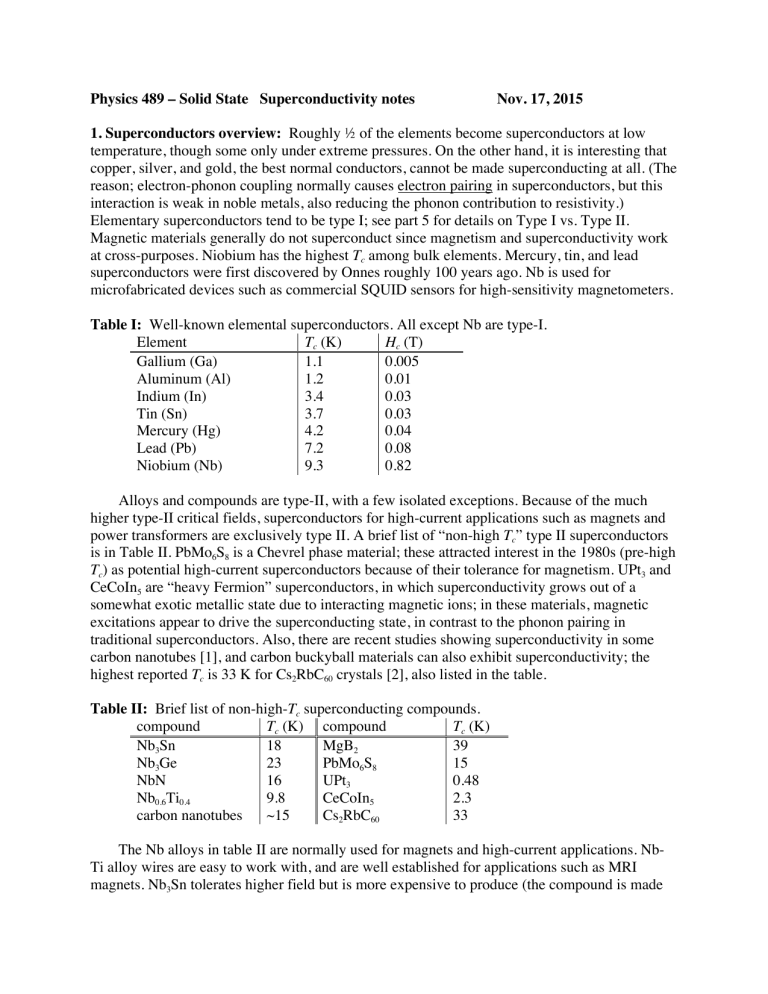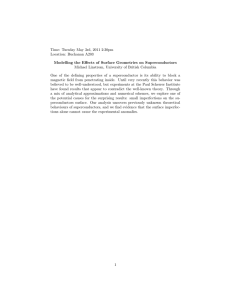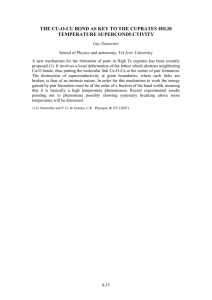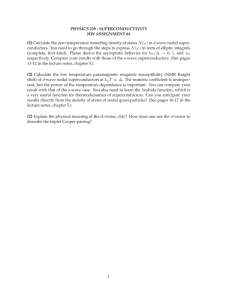Physics 489 – Solid State Superconductivity notes

Physics 489 – Solid State Superconductivity notes Nov. 17, 2015
1. Superconductors overview: Roughly ½ of the elements become superconductors at low temperature, though some only under extreme pressures. On the other hand, it is interesting that copper, silver, and gold, the best normal conductors, cannot be made superconducting at all. (The reason; electron-phonon coupling normally causes electron pairing in superconductors, but this interaction is weak in noble metals, also reducing the phonon contribution to resistivity.)
Elementary superconductors tend to be type I; see part 5 for details on Type I vs. Type II.
Magnetic materials generally do not superconduct since magnetism and superconductivity work at cross-purposes. Niobium has the highest T c
among bulk elements. Mercury, tin, and lead superconductors were first discovered by Onnes roughly 100 years ago. Nb is used for microfabricated devices such as commercial SQUID sensors for high-sensitivity magnetometers.
Table I: Well-known elemental superconductors. All except Nb are type-I.
Element T c
(K) H c
(T)
Gallium (Ga)
Aluminum (Al)
Indium (In)
Tin (Sn)
Mercury (Hg)
Lead (Pb)
Niobium (Nb)
1.1
1.2
3.4
3.7
4.2
7.2
9.3
0.005
0.01
0.03
0.03
0.04
0.08
0.82
Alloys and compounds are type-II, with a few isolated exceptions. Because of the much higher type-II critical fields, superconductors for high-current applications such as magnets and power transformers are exclusively type II. A brief list of “non-high T c
” type II superconductors is in Table II. PbMo
6
S
8
is a Chevrel phase material; these attracted interest in the 1980s (pre-high
T c
) as potential high-current superconductors because of their tolerance for magnetism. UPt
3
and
CeCoIn
5
are “heavy Fermion” superconductors, in which superconductivity grows out of a somewhat exotic metallic state due to interacting magnetic ions; in these materials, magnetic excitations appear to drive the superconducting state, in contrast to the phonon pairing in traditional superconductors. Also, there are recent studies showing superconductivity in some carbon nanotubes [1], and carbon buckyball materials can also exhibit superconductivity; the highest reported T c
is 33 K for Cs
2
RbC
60
crystals [2], also listed in the table.
Table II: Brief list of non-highT c
superconducting compounds. compound T c
(K) compound T c
(K)
Nb
3
Sn 18 MgB
2
Nb
3
Ge
NbN
23
16
PbMo
6
S
8
UPt
3
Nb
0.6
Ti
0.4
9.8 CeCoIn
5 carbon nanotubes ~15 Cs
2
RbC
60
39
15
0.48
2.3
33
The Nb alloys in table II are normally used for magnets and high-current applications. Nb-
Ti alloy wires are easy to work with, and are well established for applications such as MRI magnets. Nb
3
Sn tolerates higher field but is more expensive to produce (the compound is made
by chemical reaction after winding the wires). Pictured below at the left is a Nb-Ti wire (CERN website) with 6300 strands of 6 µm-dia. superconductor drawn in a copper matrix. This is typical for superconducting magnets; the small filaments minimize the motion of superconducting vortices (a type-II feature), since dissipative motion of vortices can quench the wire to a normal state. In center is a schematic of a tape developed more recently for high-Tc YBCO cables, and at right a free-standing model transmission cable based on high-Tc BSCCO.
"HighT c
" often refers specifically to the cuprates, or copper-oxide materials. The first discovered was La
2-x
Sr x
CuO
4
, T c
= 38 K, by Bednorz and Müller (Nobel prize 1987). There has since been a large number of copper-oxide-based superconducting compounds synthesized -- see
Table III.
Table III: High-Tc cuprates, Fe pnictides, and related superconducting materials.
Compound T c
(K) Compound T c
(K)
(La,Sr)
2
CuO
4δ
(LSCO) 38 LaFeAs[O
1-x
YBa
2
Cu
3
O
7-
δ
(YBCO)
Bi
2
Sr
2
Bi
2
Sr
2
CaCu
2
O
9
Ca
2
Cu
3
O
10
95 GdFeAsO
(BSCCO 2212) 110 BaFe
2
As
2
(BSCCO 2223) 110 FeSe
1-x
F x
]
Hg
2
Sr
2
Ca
2
Cu
3
O
8
134 LiFeAs
26
53
38
8.5
18
(Nd,Ce)
2
CuO
4
(electron doped) 35 Sr
2
RuO
4
0.93
The second material, YBa
2
Cu
3
O
7-
δ
(YBCO), was discovered by Paul Chu shortly after the initial discovery of LSCO. It is technologically much more important with T c
above 77 K (liquid
N
2
boiling temperature). One application for cuprates to date has been coils in high-efficiency microwave filters commonly used in cell-phone towers. BSCCO materials are also important for next generation high-current cables—generally still limited to niche applications and demonstration projects.
Structurally, the cuprates have planes containing (CuO
2
) units, shown at left (Ru in the figure refers to alternate materials, the ruthenates.). Below is shown the full structure [3]: labeling is for (La,Ba)
2
CuO
4-
δ on the right, and (Sr)
In the formula (La,Ba)
2
CuO
4δ
2
RuO
4-
δ on the left.
,
δ
indicates that some oxygen ions between planes are missing, which has the effect of creating holes. It is usually the holes that conduct electricity; without them
La
2
CuO
4
is an insulating antiferromagnet.
An additional feature of most cuprates is that they are electronically two-dimensional. This means, from a band perspective, the band masses are very large in the c direction. The behavior is often modeled as parallel two-dimensional superconducting sheets (Cu-O planes) separated by
insulating layers, where superconducting pairs can move in the c direction only by tunneling.
(Tunneling of pairs, rather than single electrons, is Josephson tunneling.) This also can also cause magnetic vortices in each layer to become decoupled, and makes the problem of flux pinning at high currents more difficult.
The microscopic parameter
κ
(defined in part 5 below) is particularly large for the cuprates. For
λ ξ
100 nm and 1 nm, respectively, giving
κ
= 100. For comparison in type-I aluminum is 20 nm and
λ
ξ to the pair binding energy.
Finally, some iron pnictide superconductors
[4] are listed in the right-hand column of Table III.
The initial 2008 report of La[O
1-x
F x
]FeAs with a surprisingly high T c
led to a focus on these materials that continues to the present. Since then the 122 family (BaFe
2
As
2
), as well as 111 (LiFeAs) materials and 11 FeSe and FeTe have been demonstrated as superconductors. These materials feature two-dimensional Fe-containing structural layers, and the picture that has emerged is of unconventional superconductivity that shares some common features with that of the cuprates.
2. London equation, London penetration depth: The London theory starts with simple assumptions based on macroscopic properties: that superconducting electrons accelerate without resistance, and the internal
( which for superconducting pairs becomes – q = –2 e ), with no resistance d dt j
!
= nq m
2 !
E
B
.
field of a superconductor is zero (Meissner effect). For a charge –
Taking the curl of both sides of [1], and using Faraday’s law (
×
!
E = −
1 c d v
∂
[1]
!
B dt dt
= − q m
), yields
!
E so: q d dt
⎜⎜⎝
⎛
× j
!
+ nq mc
2
B
⎞
⎟⎟⎠
= 0 . [2]
Equation [2] can be solved by a time-independent current density and B field, and this leads to the expectation that a perfect conductor would retain any magnetic flux that originally flows through it. The brothers Fritz and Heinz London noted that setting the parenthetical expression in
[2] to zero is consistent with the observation that superconductors expel fields (the Meissner effect ). This yields what is now called the London equation :
× j
!
= − nq mc
2
B ≡ −
4 c
πλ
2
B , [3] found to provide a good description of the macroscopic response of superconductors to a magnetic field. The last form of the expression defines the London penetration depth ,
λ
= mc 2 4 π nq 2
. ( Note corrections/additions .) Another expression equivalent to [3]:
∇ ×
×
= −
1
λ 2 is obtained via Ampere’s law (
,
×
B = 4 c
π
[4] j ). These expressions can be used to show that both B and
− ∇ 2 j
!
+ (
!
⋅ B ) , in which the second half vanishes identically from Gauss’ law. Therefore,
∇
2 = /
λ
2
, for which a solution (near a flat surface) is that B decays exponentially as
[5]
B = B ext e − x / λ
. From this and from [3] we also find that whenever the B field penetrates in a thin surface region, there is a current density j which decays exponentially near the surface in the same way as B . The value of
λ
in most materials is between 10 and 100 nm, thus for a bulk superconductor (at sufficiently low fields) the Meissner effect is accomplished by a thin exponentially-decaying surface current
Finally, with
j
=
B
−
= c
4
πλ 2
A , [3] is equivalent to another form of the London equation,
A . [6]
Note that [6] is valid specifically in the Coulomb gauge (
A
=
0 ); see Appendix G of Kittel.
3. Interactions forming pairs, BCS theory: Superconductivity as explained by the BCS theory (Bardeen, Cooper, Schrieffer, 1957) relies upon pairing of electron states, due to an attractive interaction mediated by phonons. As an approximate way to understand an electron attraction with the assistance of phonons, consider the positive ions (charge Q ) as classical
E cos
ω
t is cos ω t =
−
M
Q E
( ω 2 cos
−
ω t
ω o
2 )
, [7] with the natural frequency of the oscillator,
ω
o force direction, but at frequencies higher than
ω
= o we can replace
ω
κ
M . At low frequencies [7] is along the
there is a 180° phase shift. For phonon modes o
by a phonon frequency, which can be considered small since electrons move much faster than the ions. The result of such reverse-phase ionic displacements can be shown to be a contribution to the dielectric function,
ε ( q ) = 1 − Ω
2
ω 2
. [8]
The cutoff frequency Ω turns out to be the ionic plasma frequency; it is much smaller than the ultraviolet plasma frequency for charged electrons. Even with other typically positive contributions to the electrical susceptibility added, the result [8] can dominate, giving a negative dielectric function for a range of frequencies. The negative sign changes the electron-electron
Coulomb interaction from repulsive to attractive. This is the "overscreening" concept.
In highT c
oxide superconductors such as YBa
2
Cu
3
O
7-x
(YBCO, as mentioned above) it is likely that the pairing is not due to phonons, however normally phonons are the “glue” that binds the electrons. The isotope effect was an early clue that this was the case: as described in more detail in the text, the isotope effect is a small change in T c phonon coupling T c
is proportional to M
−
1/2
, where M
due to a change in isotope mass; for
is the isotope mass, and this is very close
to what is observed. Careful sample preparation is required to assure that the effect is not dwarfed by other sample-dependent changes. The M dependence arises through connection to the Debye frequency, described below;
ω
D
is related to the speed of sound, and the speed of sound generally is proportional to 1 M .
The phonon-mediated interaction is at most very weakly attractive in ordinary metals, however in quantum mechanics a very weak attractive potential does not necessarily support a bound state. Cooper showed how two electrons could interact in the presence of a filled Fermi sea to form a wavefunction with lower energy than that of two electrons which do not interact.
For simplicity, he assumed a spherical Fermi surface, and took the attraction between electrons
( V ) to be constant up to a cutoff energy, taken to equal ω
D
, which is the highest phonon energy in the Debye model, since the phonons cause the weak attraction. The resulting pair energy is
E = 2
ε
F
− 2 !
ω
D e
− 2 g ( ε
F
) V
. [9]
In this solution there is no minimum attractive energy (minimum V ) required to obtain a bound state. Hence, V need only be positive, and even the weak phonon-mediated attraction can be enough to drive an electronic phase transition. A Cooper pair is a superposition of many planewave states, ordinarily in an s -state (arranged in a many-body wavefunction with spherical symmetry). The size of a pair for elemental superconductors is about 10000 Å, but for highT c oxide superconductors a representative value is 20 Å. The pair size is the coherence length , defined as
ξ
. Together,
ξ
plus the London penetration depth,
λ
are the two important length scales for the description of superconductivity.
The BCS ground-state wavefunction is made by filling the metal with Cooper pairs. At zero
Ψ =
A
Ψ
(
1
,
2
)
Ψ
(
3
,
4
)
Ψ
(
5
,
6
)...
. [10] where each of the pair wavefunctions in the product is identical. The operator A makes the whole wavefunction properly antisymmetric (makes the state a Slater determinant) as required for
Fermions. The wavefunction hence obeys Fermi statistics for interchange of electrons.
However, the pairs themselves are identical and obey Bose-Einstein statistics: Fermions thus can act like Bosons. The BCS ground state can be regarded as a Bose-condensed fluid of identical pairs. If the magnitude of the attractive interaction between electrons were to increase, the ground state would change from a BCS-like state to one characterized by isolated electron-pair
“molecules” which can also Bose condense. The latter is the regime of cooled atomic gases. The
BCS regime is in the opposite extreme, where the pair wavefunction is spatially very large, such that the pairs themselves are heavily overlapping.
4. Energy gap With the electrons paired as in [10], there is an energy gap, E g
≡
2
Δ required to break a pair. Also there is found to be a modified density of states for excitations as sketched below: the states “pile up” on the two sides of the gap. On the right is a figure from a tunneling measurement (STM), one method to observe the gap directly.
The superconducting transition temperature ( T c
2 Δ = 3.53
k
B
T c
.
) is related to ∆ in the BCS theory according to:
[11]
5. Ginzburg-Landau theory: In the Ginzburg-Landau model, the superconducting state is characterized by an "order parameter"
ψ
( r ) .
ψ
( r ) is a pseudowavefunction: much like a wavefunction but with no microscopic features (think of a Bloch wavefunction with the atomicscale details smeared out).
ψ
( r ) can be regarded as having the phase of the paired wavefunction, and an amplitude such that |
ψ
( r ) |
2 = n s
, the density of superconducting electron pairs. This model is valid for slowly varying fields. One of the basic relations is for the electric current density, obtained assuming |
ψ
( r ) |
J el
= −
⎡
⎣
2 e mc
2
A
+ e m
2
is a constant:
φ
⎤
⎦
|
ψ
|
2
, where the phase
φ
is defined according to ψ
( r )
=
|
ψ
| e i
φ
[12]
. Eqn. [12] can be obtained directly from the quantum-mechanical result that I derived last time, assuming that ( i ) the amplitude of
|
ψ
( r ) |
2
is fixed, with only the phase varying vs. position, and ( ii ) the particles represented by the wavefunction have charge given by 2 e , and mass 2 m , since they are electron pairs . The relation
[12] can be used to explain phenomena such as the Josephson effect. Also note that in cases of constant phase, [12] is equivalent to the London equation.
Flux quantization comes naturally from this theory; integrating [14] about any closed loop deep within the superconductor (where J el
must be zero), and requiring the phase change to be
2 π times an integer, one can obtain the quantization condition for the magnetic flux threading the loop (
Φ =
∫
B
⋅ d ):
Φ = hc
2 e n ≡ Φ o n , with n an integer. The flux quantum is
Φ based on the G-L theory, the quantities
[15] o
=
2
λ
and
ξ
× o
10
−
7
G
⋅ cm
2
. Also as established by Abrikosov
are among the most important microscopic parameters. The ratio of their values, those with
κ > 1 2
κ =
λ
ξ o
, divides Type-I and Type-II superconductors: are Type-II, which exhibit magnetic vortices under the application of a sufficiently large magnetic field. On the other hand Type I superconductors (with
κ <
1 2 )
expel magnetic fields from their interior under all circumstances. The magnetic vortices in Type
II superconductors each carry one flux quantum [15] of magnetic flux.
References:
Regarding books for general reference, besides Tinkham's excellent book Introduction to
Superconductivity, deGennes' Superconductivity of Metals and Alloys (re-issued 1999) provides a well-written introduction to superconductivity which lays out the BCS theory and the essential features of the superconducting state. These are classics, a bit more advanced than our treatment in class. Particularly deGennes is an excellent place to go next to understand the basic phenomena beyond what is in your text.
Rose-Innes and Rhoderick is a more elementary phenomenological treatment that is a good complement to our course. Superconductivity: A Very Short Introduction by Blundell is a more recent book along these lines.
References from above:
[1] "Superconductivity in Entirely End-Bonded Multiwalled Carbon Nanotubes", Phys. Rev.
Lett. 96, 057001 (2006) [see http://phys.org/news11668.html]; "Superconductivity in 4-
Angstrom Carbon Nanotube Arrays--A Short Review", Z. Wang, W. Shi, R. Lortz and Ping
Sheng, Nanoscale 4, 21-41, (2012).
[2] Superconductivity at 33 K in Cs x
Rb y
C
60
, K. Tanigaki, et al., Nature 352, 222 - 223 (1991); also see Superconductivity in a single-C
60
transistor, C. B. Winkelmann et al., Nature
Physics 5, 876 - 879 (2009).
[3] Physics Today, Jan. 2001; Yoshiteru Maeno, T. Maurice Rice, and Manfred Sigrist, "T he
Intriguing Superconductivity of Strontium Ruthenate ."; Evaluation of Spin-Triplet
Superconductivity in Sr
2
RuO
4
, Y. Maeno et al., J. Phys. Soc. Jpn. 81 (2012) 011009.
[4] Iron-based superconductors: Magnetism, superconductivity, and electronic structure
(Review Article); A. A. Kordyuk, Low Temp. Phys. 38, 888 (2012); “Trend: Hightemperature superconductivity in the iron pnictides”, M. R. Norman, Physics 1, 21 (2008).





